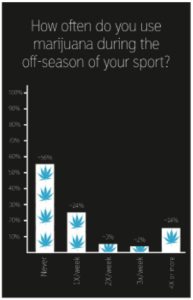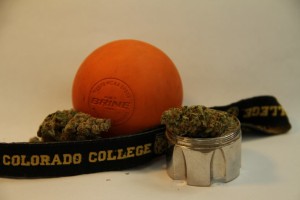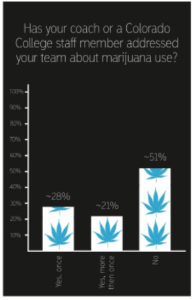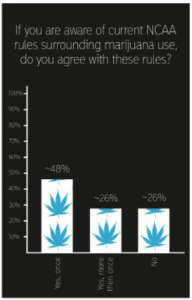Marijuana photos by Xan Marshland. Graphs by Ethan Cutler

The United States is growing greener with each passing day. Colorado College, nestled in the foothills of the Rocky Mountains and in one of the conservative hubs of Colorado, has witnessed to a momentous change in marijuana law over the past four years. The passing of Amendment 64 in 2014 placed Colorado alongside Washington as a state that allows the medical and recreational use of marijuana. These four states make up a collection of 23 in the United States that allow at least medical use of cannabis. As marijuana gains a foothold across the nation as a legal recreational drug, college campuses have had this rather sticky issue thrust into their laps. On President Jill Tiefenthaler’s CC webpage, Colorado College’s particular stance on marijuana is made crystal clear:
“Colorado College is dedicated to providing the finest liberal arts education in the country, and to achieve this mission, we seek to foster a healthy learning environment. We seek to foster a healthy learning environment. We believe marijuana use conflicts with this mission. The college has a long-standing policy against drug use on campus and within the college community, and that policy does not change with Colorado’s adoption of Amendment 64.”
Amendment 64 and college policy aside, college campuses have historically been a space where students have experimented with both alcohol and recreational drugs such as marijuana. The eyes of the nation are trained on Colorado and its higher-ed institutions to see how they deal with a perceived ease of access to marijuana, a federally illegal substance. Contained within this discussion is, of course, the student populations at these institutions. How will students use marijuana and in turn create a campus culture around these substances?
The issue of marijuana use among student-athletes at Colorado College is a timely and complex issue to explore. The issue draws in and involves athletic personnel from the upper echelons of the NCAA and resonates all the way down to the team culture that student-athletes foster.
The Catalyst talked with staff members in the CC Athletic Department, CC coaches, current athletes, and Tiger alumni to attempt to paint an accurate picture of marijuana use among student-athletes at CC. And in turn, determine what significance this use holds for CC’s future in an increasingly hazy, and at times dank, United States.
I. The Big Picture: NCAA and Federal Law
All Colorado College sports compete under the umbrella of the NCAA. The drug-testing protocol that the NCAA uses varies between the Division I and Division III levels. Ken Ralph, Athletic Director at Colorado College since 2007, spoke to this difference. “For the Division I sports there are year-round unannounced drug tests,” he said. “In fact we even have to provide their locations in the summer. Typically, they have less than 24-hour notice for testing.” While Division I athletes compete with the knowledge that unannounced drug test are possible at any time, Division III athletes are not held to this standard.
Division III athletes will only be tested at conference and national championship events. “Six or seven years ago there was a pilot in Division III to do a more extensive drug-testing program and [Colorado College] participated. But Division III ultimately thought it was much too expensive,” said Ralph. Division I athletes are held to a more rigorous standard, but the punishment for a violation is the same for athletes of both divisions.
A positive test for any sort of blood doping or performance enhancing drug results in the athlete being slapped with a year-long ban from competition. However, a positive test for “street drugs” such as marijuana, heroin, and synthetic THC holds a lesser punishment – a ban from 50% of a team’s games in a given season.
In addition to drug-testing, the NCAA collects data on the rates that student-athletes are using substances. A 2014 report found that Division III athletes self-reported the highest rates of use of social drugs (tobacco, alcohol, marijuana) in all of the NCAA. In the current NCAA landscape, the decision by a Division III athlete to use a social drug holds less serious consequences. With no random drug-testing imposed by the NCAA or Colorado College on DIII athletes, there is simply less chance that they will face a penalty for recreational use of a substance like marijuana.
At a meeting of the Division III Management Council April 13-14, 2014 there was discussion among DIII schools to altogether eliminate testing for street drugs such as marijuana at championship events. The measure ultimately stalled. Lori Runksmeier, the chair of the DIII Management Council stood by the decision, “The Management Council feels the best thing for the health and safety of our student-athletes would be to have some sort of marijuana testing. If the NCAA doesn’t do marijuana testing, it’s harder to justify it on our campuses when we think it could work there.”
The fact that marijuana was a part of this conversation could bode well for it’s eventual elimination from the NCAA drug-testing regimen. However, for the time being, Colorado College athletes are making their decisions with the knowledge that NCAA drug-testing could occur at any time for DI athletes, and will occur at DIII championship events.
II. Marijuana at the moment: Current use among CC athletes
The data that the Catalyst Sports team was able to collect indicated that CC student athletes use marijuana at a slightly higher rate than the national average for American college students. According to a 2014 report from the University of Michigan, 36 percent of college students reported using marijuana in some form in the previous year. Of the 62 responses collected from athletes across all sports at CC, 43.55 percent of athletes reported using marijuana at least once a week in the off-season of their sport.
Substance use among athletes can be closely linked to the time of year that a student-athlete finds themself in. The number of athletes that reported using marijuana at least once a week during the season of their sport dropped to just under 25 percent This precipitous spike is due in large part to a team culture that is developed among teams at Colorado College. Leading up to championships of Division III sports most teams institute what is known as “dry season” and players cease all use of recreational drugs in preparation for a crucial part of the season.
Ian Carey, a sophomore member of the men’s swim and dive team spoke to the concept of a “dry season.” “That’s enforced by the captains,” he said. “So no drinking, no smoking, no anything. There are people that choose not to partake, but it’s sort of a socially enforced thing.”
The men’s lacrosse team employs a similar model according to 2014 alum and former honorable-mention All-American Henri Halle. Halle acknowledged that the men’s lacrosse team has been stereotyped in the past as some of the heaviest marijuana users on campus, but also said that there is some truth to this perception. For most of the season the team was not worried about being drug-tested. But come time for the NCAA tournament, “absolutely, the captains made it very clear that there was no use in the month leading up to the tournament. Yeah, some kids break that rule, but the captains dealt with that.”
Halle was a standout player over his career for the Tigers and in his senior year, after recording 33 goals on the season, was invited to the prestigious USILA All-Star game in Baltimore, Maryland. For Halle, smoking marijuana was something that he did “every day my senior year and still had the best season of my career.” Halle came into CC his freshmen year having never smoked marijuana in season during his high school career, “but gradually throughout the years I smoked more and more in the season and felt OK about it.”
The lack of mandatory drug-testing at the DIII level provided Halle with a higher degree of “social freedom.” In Halle’s experience at CC the men’s lacrosse team had a culture that was more accepting of marijuana use. “Honestly, on the lax team, a higher percentage of guys are regular users.” Halle saw a distinct difference between his men’s lacrosse teammates and the women’s soccer team, who as Division I athletes “could never fathom why we were smoking weed.”
The NCAA has found in their analysis of substance use in DIII athletics that men’s lacrosse uses marijuana at a higher rate than all other sports demographics. So Halle’s experience does not fall outside the bounds of statistical evidence, but what Halle communicated was that substance use was unacceptable when it hurt the team and the goals that the team had set for its season. Last season, Halle and his fellow captains enforced a no-drug policy in the month leading up to the Tigers postseason berth and eventual loss to No. 9 Endicott College in the first round of the NCAA tournament.
For Division III athletes at CC, the risk of using marijuana in the off-season or even the early part of the season is relatively low. However, for Division I athletes there is a much different set of rules and level of risk. Halle said, “Immediately, you can separate DI and DIII athletes in the discussion about marijuana.” While the consequences are certainly higher for DI athletes, the culture around marijuana on the men’s hockey team, according to 2014 graduate and former backup goalie Courtney Lockwood, was rather “cavalier” during his time with the team from 2011 to 2013.
“No one was like a pothead,” said Lockwood. “I know there are some guys on the team now that really consistently smoke. When I was playing there was about 50% of the team that had tried it at least once during the season. But who knows what they would do during the offseason.” Also, from Lockwood’s viewpoint the NCAA drug tests that the players were subjected to did not punish players that had been using marijuana recreationally, as the tests focused mainly on performance-enhancing drugs, or PEDs.
Lockwood has been away from the team since the end of the 2013 season. In the time that Lockwood was on the team he felt that recreational drug use was not being cracked down upon by either the NCAA or former coach Tim Owens. Lockwood said, “There were guys on the team that would consistently smoke or definitely use painkillers for fun and when they were tested, they would pass with flying colors.”
Lockwood’s opinion on marijuana stands in stark contrast with the experience of Halle and a culture of marijuana use on the men’s lacrosse team. For Lockwood, a lack of discipline and structure around substance use on the men’s hockey team had led to a slow crumbling of the team’s foundation.
Lockwood had this to say in regards to the policies around drug use under former coach Tim Owens. “I do think it needs to be strict,” he said. “At CC, you’re having too many kids that are coming in and there’s no discipline, no one’s held accountable. I grew up going to CC hockey games and I watched a program that was a national contender turn into the worst team in the f***ing league and the worst team in the country. I’m not going to say that it’s because of marijuana but it’s because these kids are allowed to get away with s**t like that that leads to this general malaise attitude. Like, ‘Whatever, it’s not going to affect me.’”
A mixture of team culture, NCAA policies, and personal prerogative plays into each athlete’s individual decision to use or not use marijuana. On an institutional level, Ken Ralph and the Athletic Department are working to create an environment in which young adults can learn to make responsible decisions and seek support if experimentation turns into debilitating abuse.
 III. A supportive approach: CC Athletics
III. A supportive approach: CC Athletics
Since arriving in 2007 from Rensselaer Polytechnic Institute, Athletic Director Ken Ralph has worked hard to create a culture of “understanding and education” between CC’s student athletes and the Athletic Department. In regards to dealing with marijuana use among student athletes, Ralph said, “We try to remember that first and foremost they are students and they are part of a larger peer group and that they’re young adults and they’ll have to learn to make responsible decisions that are best for them.”
After piloting a drug-testing program in 2009, the Athletic Department decided that it would be much more cost effective and beneficial to players to forego conducting drug tests for DIII athletes. For Ralph, the driving force behind drug testing policy at CC is creating a system of support, rather than push drug use into a dangerous underground situation.
Ralph said, “I don’t want to be intrusive in the lives of our students. I don’t think it’s fair to them, and I think it inhibits the trust that we try to build. When you build a good relationship with your students they tend to offer some things up.”
Head lacrosse coach Sean Woods, similar to Ralph, stands in opposition to any sort of drug-testing on the part of the CC Athletic Department. “It dummies my job, said Woods. “It dummies the leadership. Our mission at this college is to educate and my job as a coach is that these young men are leaving better people four years from now. I think it would take away from my mission if we did drug test.”
While Woods did not support drug-testing from the college he emphasized the special type of athlete that even chooses to go to CC in the first place. Woods had high praise for CC athletes. “[Colorado College athletes] are ambitious,” he said. “In order to get into this school you need to be a great young mind. You have to care about your future. You have to be responsible.”
At the end of the day, it is clear that championship and continue CC’s rise in the world of DIII lacrosse. A national championship is the goal of Woods’ entire squad and from Woods’ point of view, marijuana is a distraction on the team’s road to success. “If they are doing something that is preventing them from accomplishing their goals, then I don’t think that’s such a good thing to be doing,” said Woods.
In addition to providing support for athletes, the CC Athletic Department provides athletes with information on nutrition and the effects that marijuana can have on the bodies of young athletes. Most recently, Woods and the lacrosse team hosted a nutritionist who talked to the players about the marijuana use. “It was really effective, I think our guys learned quite a bit and it’s something we always need to talk about.”
In an online poll of student-athletes, just over 50 percent of respondents had never had a CC coach or athletic department member address their team about marijuana use. In light of this statistic, Woods’ approach with the men’s lacrosse team stands out but is obviously a conscious effort by Woods to create an atmosphere of healthy growth.
Wood’s five-year tenure with the Tigers has not been without its share of violations from players. Woods spoke to a collection of incidents of varying severity. “Yes, we’ve had guys that have got caught that I have had to come down on,” he said. “We’ve had to remove kids from the team that repeatedly broke the rules. We’ve had a guy step away from the team for a little while and hopefully see what he’s missing. It’s a privilege, not a right to play lacrosse at [Colorado College].”
For Coach Woods, the bottom line is rather cut and dry. “It’s not going to help you practice better, it’s not going to help you compete better, it’s not going to help you with studying,” he said. “Neither will alcohol and neither will any altering substance.”
In dealing with young adults Ralph and the rest of the CC Athletics staff have worked to create a culture of accountability, but have also balanced that with a non-accusatory and supportive basis of trust. Ralph said, “I want to be respectful of the decisions our students make and give them resources in case those choices get out of hand.”
IV. Prospies and pot: Marijuana’s effect on recruitment
As Colorado College gains prominence as a nationally-respected liberal arts school admission rates have dropped and applications have increased. Since 2009, the percentage of each class that is made up of athletes has hovered around 14 percent. It is constant work for coaches and administrators to attract athletes to CC that are academically motivated and have the talent to bring home championship banners to Reid Arena.
Marijuana has played an impact on recruiting in the eyes of Ralph. “We know it has a negative impact on recruitment, especially if prospective students are in dorms and they are overwhelmed by the smell of marijuana smoke in the dorms. We’ve heard that on many occasions.”
On his visit to CC as a prospective student, Carey was hosted by a heavy marijuana smoker. “The person that I stayed with was one of the heaviest smokers on the team so I was immediately kind of like, whoa this is a lot.” Carey later learned that his host didn’t represent a norm for the team and was able to make his decision based on this knowledge. From Ralph’s perspective, other prospective students that have experiences with marijuana on visits may choose not to attend the college because of the marijuana use on campus.
While marijuana may play a role in the recruiting visits of DIII student-athletes, Lockwood thinks that substance use and campus culture play into prospective hockey recruit’s decision-making process much less. “For blue-chip recruits, I think the only thing that they are focused on is the team’s record and how they are going to get to the next level. It’s a much narrower scope. They don’t really think in terms of scope or flexibility or being able to explore themselves or any of that crap,” said Lockwood.
As a national trend, applications to colleges in Colorado have spiked since the legalization of recreational marijuana in 2012. No statistics are available for athletes specifically, but applications at CU-Boulder for example have risen 25 percent since 2012 according to USA Today. Of course, marijuana is not legal for those under 21, but medicinal and recreational marijuana create an ease of access for college students under the age of 21. For some prospective athletes, the opportunity to experiment with marijuana may draw them to the school. Overall, Ralph sees marijuana use among athletes and perceived use as a drawback to CC’s ability to recruit top talent from around the nation.

V. Moving forward in a legal marijuana landscape
Colorado College and its student-athletes will continue to grapple with issues around marijuana moving forward. However, student-athletes and Colorado College may see the landscape of the NCAA change in the years to come.
At the most recent summit of DIII athletic institutions a new model of drug prevention for DIII athletes was proposed. The proposal moved the focus away from traditional drug-testing and put more emphasis on educational programs on college campuses. The move was catalyzed by the fact that, according NCAA.org, “Student-athlete drug use survey data indicate drug testing at championships hasn’t deterred recreational drug use.” According to the NCAA, rates of marijuana use among student-athletes have remained steady for the past 30 years. Furthermore, the policy may change in the coming years due to data that has shown that athletes who are suspended for marijuana use end up dropping out of school at a much higher rate than the national average.
Ken Ralph does not see marijuana becoming a serious issue for the NCAA moving forward. “I’m not sure it’s going to get a tremendous amount of attention in Division III,” he said. “I think it’s going to be treated much more like alcohol, which nobody sees as a performance enhancer.”

Coach Woods had a split opinion on the issue. “I don’t really feel very strongly either way,” he said, “If it’s not a performance-enhancer I don’t see the need to test, I guess. At the same time I understand that it’s an illegal drug so I can’t say I’m against testing for something that is illegal.” Marijuana remains a Schedule 1 substance at the federal level and Woods, along with his fellow CC coaches will continue to lead their teams with this reality in mind. In order to receive federal funding, CC and the Athletic Department must abide by federal law, which currently classifies marijuana as illegal.
The fact remains for the CC Athletics that they are dealing with a group of young people that are functioning within a larger peer group, as discussed by Ralph. At CC, this peer group contains students that choose to experiment with marijuana in their lives. Some athletes choose to partake in this same experimentation. For athletes such as Henri Halle, a balance could be struck between marijuana use and on-field success. Current athletes and athletes for years to come at CC will be faced with the task of forming their own relationship with substances and marijuana. The good news for these athletes is that they will have a supportive and education-minded Athletics Department behind them every step of the way.
David Andrews
Latest posts by David Andrews (see all)
- $700 Million and Counting: What You Need to Know About the Endowment – Dec 17, 2016
- Colorado College President Jill Tiefenthaler – Dec 17, 2016
- English Professor Natanya Pulley – Dec 3, 2016
